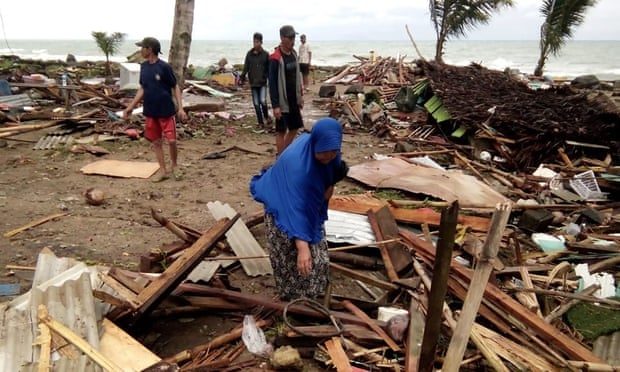
© SEMI/AFP/Getty ImagesResidents inspect the damage to their homes on Carita beach in South Sumatra, Indonesia, after the area was hit by a tsunami that may have been caused by the Anak Krakatoa volcano.
At least 168 people died and hundreds more injured when a tsunami apparently triggered by an erupting Mount Krakatoa hit beaches around Sunda Strait in Indonesia on Saturday night.
The waves were apparently triggered by a combination of underwater landslides caused by the eruption of Mount Krakatoa and an abnormal tidal surge due to a new moon, Sutopo Purwo Nugroho, the national disaster agency spokesman, said.
He said dozens of buildings were destroyed by the wave, which hit beaches in South Sumatra and the western tip of Java about 9.30 pm local time on Saturday.
Mr Nugroho later said the death toll had risen to 168, with 745 injured and 30 missing. "This number will continue to rise considering not all places have been checked," he added.
Endan Permana, head of the agency in Pandeglang, told Metro TV police were providing immediate assistance to victims in Tanjung Lesung in Banten province, a popular tourist getaway not far from the capital, Jakarta, as emergency workers had not arrived in the area yet.
"Many are missing," Permana said.
Comment: UPDATE: On Dec. 24th the
Guardian reports:
The spokesman for Indonesia's natural disaster agency has said the country must develop a new tsunami early warning system, as the death toll from Saturday's tragedy rose to more than 280.
Hundreds of military personnel and volunteers spent Monday scouring debris-strewn beaches in search of survivors as experts warned of more tsunamis following the volcanic eruption that caused the deadly wave in western Java.
On Monday morning, the nation's disaster agency said 281 people had died and at least 1,016 people were injured. More than 600 homes were damaged, as well as 60 shops and 420 vessels.
The tsunami was believed to have been caused by the eruption of the Anak Krakatau volcano, which partially collapsed, creating an underwater landslide.
Sutopo Purwo Nugroho, the head spokesman for the agency, said Indonesia had no early warning system for landslides or volcanic eruptions.
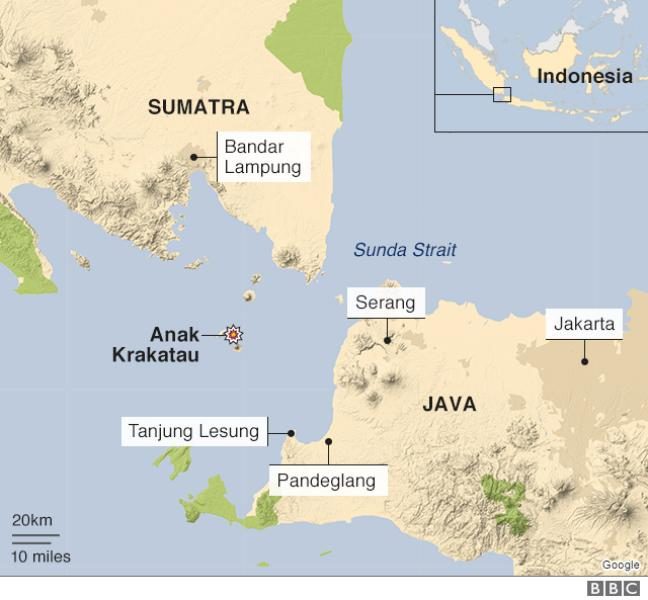
© BBC/google
He also said Indonesia's tsunami buoy network had "not been operational since 2012".
"Vandalism, a limited budget, and technical damage mean there were no tsunami buoys at this time. They need to be rebuilt to strengthen the Indonesian tsunami early warning system."
The death toll is expected to rise as 57 people were still missing on Monday. Sixteen-hundred people have also been displaced.
Dody Ruswandi, a senior official at the disaster agency, added that the rescue effort was likely to last a week.
Drone footage shows damage caused by Indonesian tsunami:
The BBC
reports:
It is not clear at this stage whether part of the flank of the volcano has collapsed with material entering the sea and pushing water ahead of it, or if movement on the flank has triggered a rapid slump in sediment under the water surface.
The latter at this stage appears to be the emerging consensus, but the effect is the same - the water column is disturbed and waves propagate outwards.
Were there danger signs before the tsunami?
Anak Krakatau has seen increased activity in recent months. Indonesia's geological agency says the volcano erupted for two minutes and 12 seconds on Friday, creating an ash cloud that rose 400 metres above the mountain.
It recommended that no-one be allowed within 2km (1.2 miles) of the crater.
After the tsunami struck, there was confusion over what had actually happened, with Indonesian disaster agency spokesman Sutopo Purwo Nugroho initially reporting it as a tidal surge.
He later apologised for his mistake, saying there had been confusion because there was no earthquake.
High seas as a result of the full moon might have contributed to the strength of the waves, the disaster management agency said.
The proximity of the volcano to the coast gave authorities very little time to act, Professor David Rothery from The Open University told AFP news agency.
"Tsunami warning buoys are positioned to warn of tsunamis originated by earthquakes at underwater tectonic plate boundaries," he said.
"Even if there had been such a buoy right next to Anak Krakatau, this is so close to the affected shorelines that warning time would have been minimal given the high speeds at which tsunami waves travel."
Adding to the anxiety on Sunday, a tsunami warning went off by mistake, causing widespread panic as people scrambled to reach shelters. A technical error is suspected.
Update: Zero Hedge
reports death toll has climbed to 373, 1,400 Wounded:
As expected, the death toll from Saturday night's devastating tsunami in the Sunda Strait has nearly doubled over the past day as Indonesia authorities have expanded their efforts to recover the dead and save any injured found alive. According to the latest count, the death toll has climbed to 373 from 222, with 1,400 injured, according to the Washington Times.
Body bags were laid out along the shattered coastline as Indonesian authorities stepped up efforts to collect the dead and save the injured Monday in the aftermath of a tsunami that was apparently triggered by a volcanic eruption. The death toll climbed to 373 and was certain to rise.
More than 1,400 people were injured and at least 128 were missing after the killer waves slammed into western Java and southern Sumatra without warning Saturday night, smashing homes to pieces and sweeping locals and Christmastime tourists into the sea.
Hundreds of military personnel and volunteers brought in by the government and international charities are searching the beaches of Sumatra and Java that were impacted by the wave.
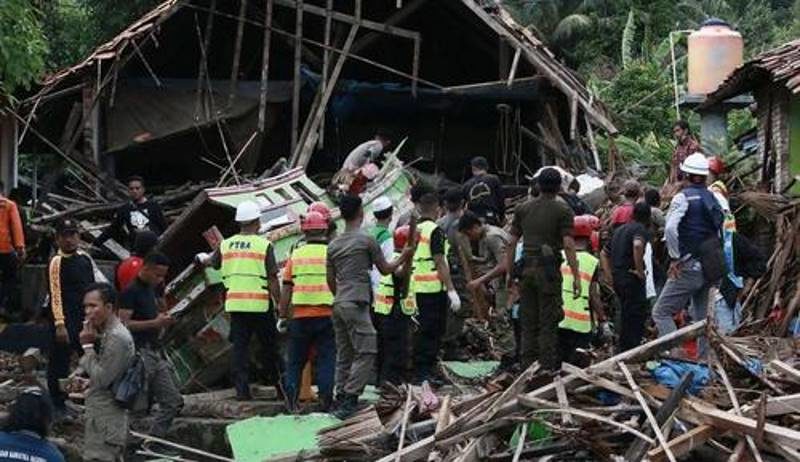
Rescuers look for survivors
From the
Daily Mail:
Dramatic aerial footage has emerged of the moment Mount Anak Krakatoa erupted as a pilot flew overhead to inspect the devastation below.
Footage taken from the cockpit of the plane shows the volcano spewing enormous walls of grey ash and lava into the ocean, sending thick clouds into the air.
Government sources say the tsunami, which has killed at least 281 and injured over 1000, was caused by an underwater landslide triggered by volcanic activity.
The volcano had been erupting spewing ash and lava intermittently since June and has been considered active since 1927.
Mount Anak Krakatoa is one of 76 active volcanoes in Indonesia.
National Disaster Management Agency spokesman Sutopo Purwo Nugroho said there was a chance of another tsunami.
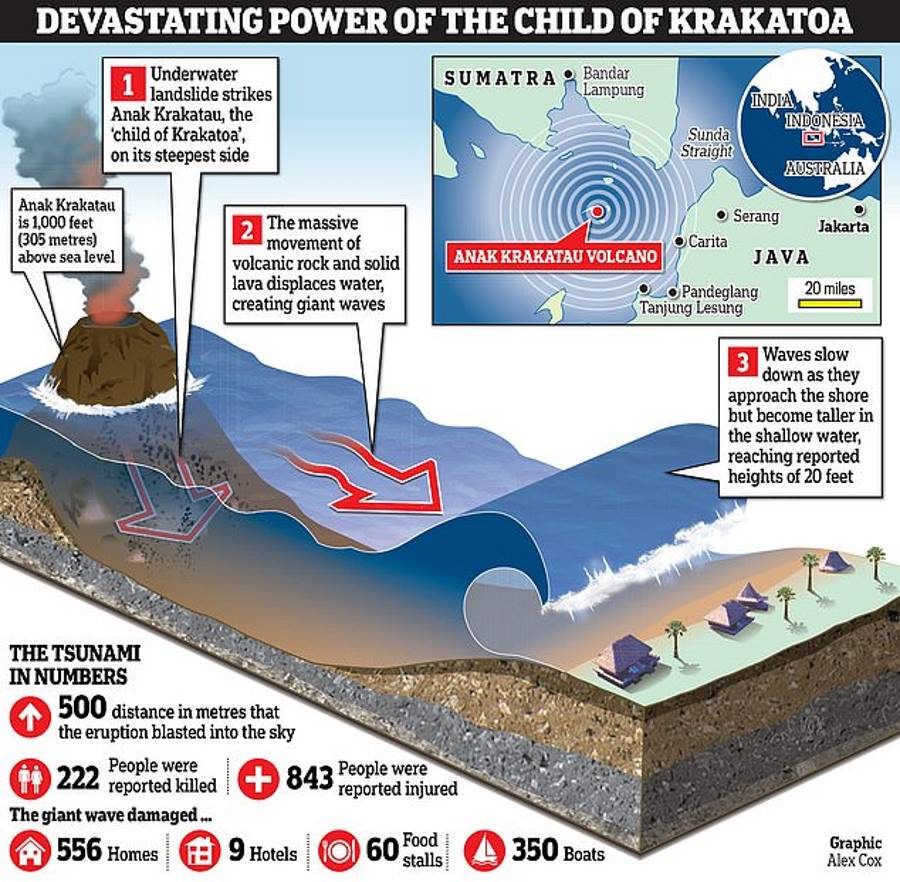
© Alex Cox/DailyMail
It has also emerged a large chunk of the volcano's south slope may have fallen into the ocean a matter of minutes before the eruption.
Seismologists say it's currently too dangerous to take sonar imaging of below the water's surface to determine the exact cause of the tsunami.
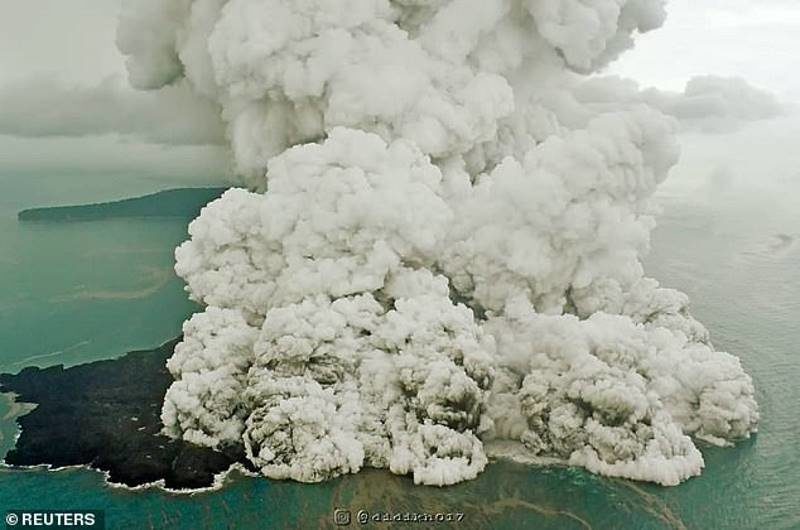
© Reutersfears are growing that constant eruptions at the mountain - dubbed Anak Krakatau, the Child of Krakatao - could trigger further tsunamis.
The Anak Krakatoa volcano erupted at about 9pm Saturday local time, triggering an underwater landslide and the ensuing tsunami.
Sixty-four hectares of the southwest side of the volcano collapsed in the eruption.
The tsunami hit between the islands of Java and Sumatra at about 9.30pm that night, destroying more than 600 homes, nine hotels, 60 food stalls and more than 400 boats.
UPDATE: On Dec. 26th CNN
reports:
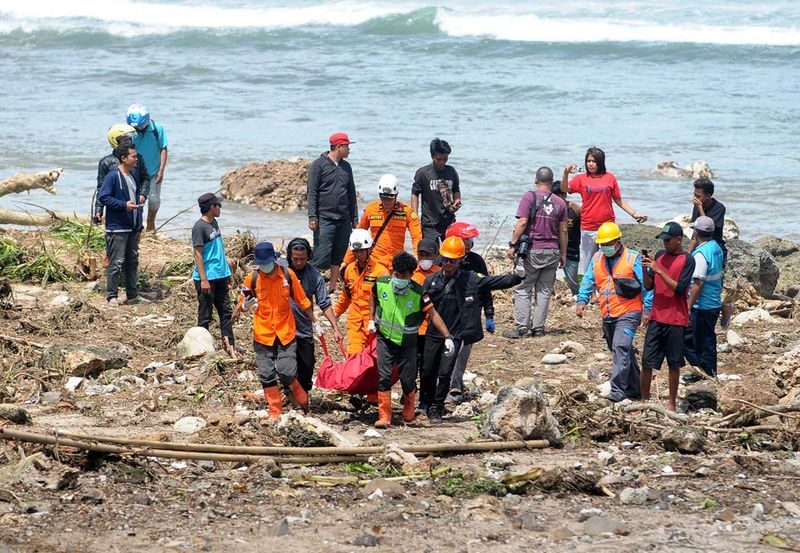
© PAExperts warn a second wave could strike the Indonesia coast, just days after a monster tsunami killed more the 400 people.
The desperate search continues Wednesday for survivors of a tsunami which struck parts of western Indonesia, as the country marks the 14-year anniversary of its 2004 Sumatra tragedy -- one of the most devastating ever recorded.
At least 430 people were killed Saturday when the tsunami -- sparked by landslides from an erupting volcano -- swept through the Sunda Strait, leaving about 1,500 injured and almost 22,000 displaced in villages on the Java and Sumatra coasts, officials said Wednesday.
Dozens of people are still missing. The Indonesia Red Cross said Wednesday that it was sending emergency aid to the affected area, with 400 staff and volunteers supporting search and rescue efforts.
"Most survivors have been huddling in temporary shelters away from the shore, but have started to emerge to search for loved ones and assess damage to their property," said Arifin M. Hadi, head of disaster management at the Indonesian Red Cross.
"Our teams are seeing many broken bones and broken homes, and people who are very shaken. Indonesians have withstood a string of disasters this year and with them, so much loss and misery."

Comment:
UPDATE: On Dec. 24th the Guardian reports: Drone footage shows damage caused by Indonesian tsunami:
The BBC reports: Update: Zero Hedge reports death toll has climbed to 373, 1,400 Wounded: From the Daily Mail: UPDATE: On Dec. 26th CNN reports: